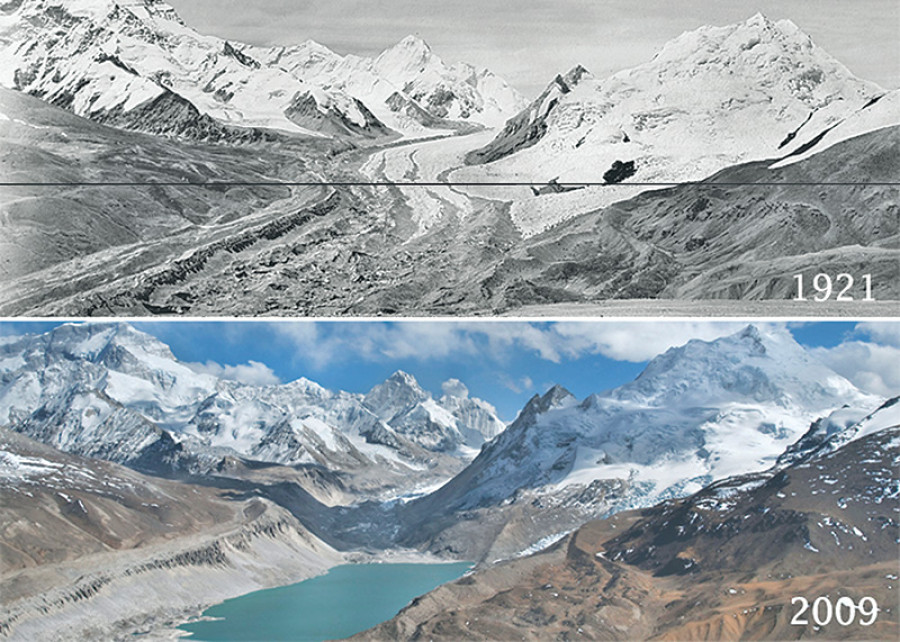Opinion
Climate crisis
Nepal is an agrarian mountainous country situated in the central Himalayas, with an altitude ranging from 60m to 8848m. Within this climatic range, the mountain ecosystem of Nepal nurtures around 118 ecosystems, 75 types of vegetation and 35 types of forest.
Tsewang Nuru Sherpa
Nepal is an agrarian mountainous country situated in the central Himalayas, with an altitude ranging from 60m to 8848m. Within this climatic range, the mountain ecosystem of Nepal nurtures around 118 ecosystems, 75 types of vegetation and 35 types of forest. Nepal also has 3,252 glaciers that encompass an area of 5323sq km. However, the mountains of Nepal are geographically fragile and are extremely susceptible to the profound effects of climate change. With the acceleration of climate change, Nepal could potentially be a target of its effects. The challenging land topography and poor socio-economic conditions make the country highly vulnerable to climate change. Over the years, Nepal has experienced a rise in average temperature. The temperature trends from 1975 to 2005 show an annual rise of 0.060C. Furthermore, the mean annual temperature of Nepal has been projected to increase between 1.3-3.8C by the 2060s and 1.8-5.8C by the 2090s.
Dire warnings
The effects of extreme warming can present a number of difficulties to vulnerable communities residing in the mountainous areas of Nepal. One of the major implications of climate change is the increased possibility of GLOFs (Glacial lake Outburst Floods). The glaciers in Nepal are retreating at a rapid pace—60m annually. And if the increase in temperature surpasses 1.5C, the retreating ice could result in floods further downstream. So far, Nepal has experienced 14 GLOFs, and an additional 20 glacial lakes in Nepal have been characterised as “potentially dangerous”.
The effects of GLOFs can create other major problems, like a slump in tourism in the country. Since certain groups in Nepal are heavily dependent on tourism, disturbances can increase the rate of unemployment and eventually weaken the economic status of the country. In addition, GLOFs also pose problems in sustaining livelihood in the mountains, thus pushing groups into poverty and also causing an extinction of biodiversity. One of the major occupations of people living in the mountainous regions is agriculture. The erratic precipitation triggered by climate change can have adverse effects on agricultural productivity and even lead to famine. Due to the difficult topography, mountain regions are isolated and hard to access. These mountain communities are extremely vulnerable as it is very difficult for them to receive immediate relief in times of disaster.
Apa Sherpa, a living legend and acclaimed mountaineer, has scaled Everest a record-breaking 20 times. Sherpa was once a farmer but decided to change profession and become a mountaineer after a GLOF swept away his home and farm in 1985. According to a 2013 study on GLOFs that was published in PLOS ONE, “In the Himalayas, catastrophic risks of GLOFs have increased in recent years because most Himalayan glaciers have experienced remarkable down wasting under a warming climate”. Evidence suggests that the extreme warming of the planet and erratic rainfall can be blamed for this. The mountaineering community has been shattered by warnings from various research studies that claim that mountains like the iconic Everest may be unclimbable in the near future.
Need for policies
Despite the dangers of climate change and its effects on the mountains of Nepal, the issue of mountain environments hasn’t been adequately addressed in international policy deliberations. Active collaboration of the international community along with an immediate response to limit the increasing trend of temperature below 1.5C can ensure the successful future of the mountain ecosystem. Developing countries like Nepal should appeal to the international community to collaborate and establish a common platform to discuss mountain concerns.
On the brighter side, active participation of local communities and many local organisations like SPCC (Sagarmatha Pollution Control Committee) have geared up to strengthen the adaptive capacities of the mountain ecosystem and increase the climate resiliency of the local communities. Concerned local authoritative bodies have been active in the strict implementation of rules along with regular assessments of forest sustainability. The collaboration between locals and the Nepal Army’s engineering department has resulted in a successful construction of a controlled drainage system in the Imja lake. With the instalment of this dam, the persistent fear among locals has been alleviated. If activities such as these continue, the mountain ecosystem and the vulnerable communities in the mountainous regions can overcome the effects of climate change.
- Sherpa is a WWF Nepal Scholar on the United States Youth Advisory Council




 16.2°C Kathmandu
16.2°C Kathmandu












